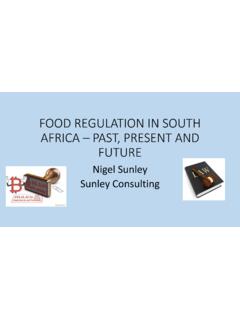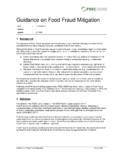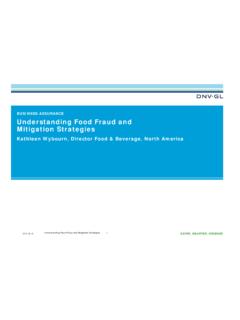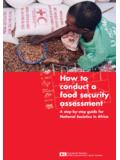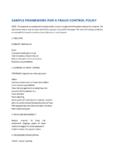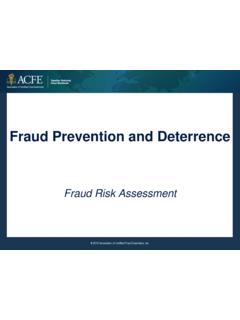Transcription of NSF Food Fraud Risk Model 29 March 2017 Ulli …
1 NSF food Fraud Risk Model 29 March 2017 Ulli Gerntholtz SAAFoST-IUFoST food Fraud Workshop vulnerability Risk assessment - Suppliers Background vulnerability Risk assessment Raw Materials The food Fraud Model This work was commissioned by the food Standards Agency (FSA) in 2013 The project aimed to create deliberately simple criteria indicative of likelihood of Fraud (measurement indices) for either the three originally proposed or subsequently modified factors such that food groups/categories could subsequently be mapped on the Boston Consulting Group (BCG) Style framework to highlight vulnerabilities enabling better targeting of surveillance measures, supply network controls and preventative interventions Use of the Model The Model delivers a working framework by which the technical and/or food safety teams in food businesses or in regulatory bodies can begin to better anticipate which product lines are most/least likely to be targeted by fraudsters and why, whether or not they have been attacked previously.
2 Use of the Model Once food products or broad food categories have been assessed in terms of their attractiveness to a predator fraudster one who is focussed on a deliberate systematic crime then interventions can be designed to thwart such activities by the application of interventions which move vulnerable products from the top right to bottom left of the Boston Consulting Group (BCG) style matrix. These interventions might include Increasing detection likelihood by increasing the frequency of or forensic quality of auditing. Changing the nature of routine third party auditing to focus more effectively on Fraud or introducing new Fraud Specific Audits.
3 Enhanced frequency or sophistication of sampling and testing regimes Making the insertion of fraudulent replacement into the supply chain more difficult by enhanced security measures. vulnerability Risk assessment - Raw Materials Think like a criminal: identify the possible frauds Assess risk with the NSF Model : Profit criteria Detection criteria Fraud easiness criteria Methodology Raw Material Risk assessment Considerations For selected raw materials to be evaluated there are a number of factors to consider; Potential Profit Factors Cost of raw material Cost of Adulterant Raw material availability Adulterant availability Economic pressure- increased demand Likelihood History of substitution or adulteration Analytical detection methods Testing frequency Supply chain complexity Cost of testing Ease of Substitution or Adulteration Physical state Method of Substitution or Adulteration Packaging type Profit criteria (1: low profit, 5.)
4 High profit) Methodology - Profit Cost of Commodity Cost of Adulterant Economic Pressure High 5 High raw commodity cost greater than 10/kg indicates that profits more likely to be high Low cost of raw commodity adulterant(s) less than indicates profits likely to be high Low availability Price increase 4 High medium raw commodity cost between 10/kg and 3/kg indicates profits more likely to be high Low-medium cost of raw commodity adulterant(s) between and indicates profits more likely to be moderate 3 Medium raw material commodity cost between 3/kg and indicates profits more likely to be moderate Medium cost of raw commodity adulterant(s) between and 3/kg indicates profits more likely to be moderate Medium availability 2 Medium-low raw commodity cost between and indicates profits more likely to be low Medium- high cost of raw commodity adulterant(s)
5 Between 3/kg and 10/kg are likely to be low Low 1 Low cost less than indicates that profits are likely to be low High cost of raw commodity adulterant(s) greater than 10/kg indicates that profits are likely to be low High availability Methodology - Likelihood Previous Reports/ Incidents Analysis method for detection (laboratory) Testing Frequency Supply Chain Complexity Cost of Testing Highly Likely 1 Current Method accredited and specific Positive release on intake Direct Supply Low cost 2 Year ago Method accredited and not specific Routine Multiple Supply 1 tier 3 1-5 years ago Method not accredited Import checks Trader 4 5-10 years ago No analytical method Volume/weight Surveillance programme/ infrequent Commodity Multi Tier Low Likelihood 5 Never No method organoleptic None/ Unavailable Co-operative/ Bulk storage High cost Likelihood criteria (Low likelihood 1 to 5 High)
6 Likelihood Fraud ease criteria = how easy on this Raw Material? Methodology - Ease Easy to Fraud Physical State Availability of Adulterants / Substitutes Ease of Adulteration/ Substitution Labelling/ Tamper Proofing (to be filled by factories only) High 5 Liquid Freely Available Dilution/ Mixing Bulk / No labelling/ No tamper proof 4 Powder Widely Available Labelling Sticker/ Removable 3 Solid/Frozen Available ( At a cost) Freezing Integral/ Tamper proof 2 Heterogeneous/ Solid/ Chilled Product Available (Expensive) Re-packing Barcode Low 1 Entire Restricted/ Technically Complex Complex processing Retail Pack Raw Material vulnerability Exercise Product.
7 Method 1 - vulnerability assessment of Raw Material Profit Criteria Score Cost of Commodity Cost of Adulterant Economic Pressure Total Score High = 5 Low=1 Average Score Detection Criteria Score Previous reports/incidents Analysis Method Testing Frequency Supply Chain Complexity Cost of Testing Total Score Likelihood High = 1 Low = 5 Average Score Use Average Score Coordinates to plot position on Model Matrix Ease of Fraud Method Score Physical State Availability of adulterants/ substitutes Ease of adulteration/ substitution Labelling/tamper proofing (factory only) Total Score Easy of Method High = 5 Low = 1 Average Score Score- Decide upon High, Medium or Low.
8 3 size sticker High Profit High Detection Low Detection Low Profit vulnerability zone assessment of Raw Material Risk vulnerability Risk assessment - Suppliers Stakeholder Identification Know your suppliers. What are your raw materials/packaging/transport? Who are the immediate suppliers? Who supplies your suppliers? When was it last reviewed? Do you need to audit your suppliers? Will a self assessment questionnaire suffice? Supplier Risk assessment Considerations Factors to consider; Business Impact Use and turnover of the raw material Volume and value of raw material supplied by the supplier Number of sites of production Supplier Assurance Country of origin Certification status Contractual/ Partnership arrangements Commercial relationship status Collaboration duration Quality evaluation (KPI s)
9 Own supply chain complexity Business Impact Level % Turn over Category For Company % Turn over Supplying Company Number of Operational Locations Supplied 1 <1% <0,5% 1 2 >1 and below 5% between 0,5 and 1% 2 3 between 5 and 7,5% between 1 to 2% 3 4 between 7,5% and 15% between 2 to 5% 4 5 above 15% above 5% 5 Supplier Assurance Level Certification Country Location Contract/ Partnership Commercial Relationship Quality Evaluation (KPI) Collaborative Duration 1 IFS + BRC Europe Partnership Good 25 >10 2 20 3 IFS or BRC Non EU - Corruption index <1,5 Contract or GPC Medium 15 4 to 10 4 10 5 nothing Non EU Corruption index ->1,5 Nothing Bad <10 <3 Suppler vulnerability Exercise Supplier: Products Supplied: Business Impact Criteria Score % TO Category % PTO Supplier To WSN No OpCos Supplied Total Score High = 5 Low=1 Average Score Supplier Confidence Score Certification Country Contract/ Partnership Organic Commercial Relationship KPI Coll.
10 Duration Total Score High = 1 Low = 5 Average Score Use Average Score Coordinates to plot position on Model Matrix assessment of Supplier Risk High Financial Impact High Confidence Low Confidence Low Financial Impact vulnerability zone vulnerability assessment Methodology assessment of the food Fraud vulnerability on raw materials 24 Cell: 083 4883202 Tel: 021 880 2024

